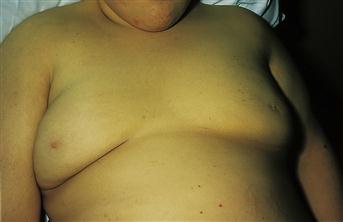Gynaecomastia
Gynaecomastia is enlargement of the male breast. There is an increase in the ductal and connective tissue elements of the breast. The condition should not be confused with fat in the mammary region, which may occur in obese patients and in old age with weight loss. In most cases, gynaecomastia is a result of an increase in the oestrogen–androgen ratio. In many cases, the actual mechanism is unknown or the cause is idiopathic.
History
In newborn babies, gynaecomastia is associated with placental oestrogens and may be associated with a milky discharge from the nipple (witch’s milk). Is the patient pubertal? A minor degree of gynaecomastia occurs in a majority of boys prior to puberty. This often regresses but occasionally remains and is a source of embarrassment. Senescent gynaecomastia occurs in the sixth decade or later.
Most cases of gynaecomastia present as painless or tender enlargement of one or both breasts. The majority of pathological causes of gynaecomastia are related to drugs. A careful drug history should be taken. Is there a history to suggest hypogonadism, e.g. undescended testes, bilateral torsion, Klinefelter’s syndrome (XXY – tall, female distribution of fat around breast and pelvis, normal male hair distribution, atrophic testes). Has the patient noticed any testicular swelling? Check for a history of alcoholism or hepatitis, which might suggest liver failure. Is the patient in chronic renal failure? This will usually be apparent as he will have been on some form of dialysis. Are there any signs of hyperthyroidism? Has the patient noticed any visual disturbance to suggest a pituitary tumour involving the optic chiasma?
Examination
Local
One or both breasts may be involved. Enlargement may be considerable, resembling a female breast, but this is rare; it is usually small and localised behind the areolar. The swelling may be soft or hard. In the younger male, the hard enlargement is usually confined to a disc of tissue behind the areola and this usually occurs around puberty. Hard irregular enlargement in an elderly man should raise the diagnosis of carcinoma. Soft or diffuse enlargement is usually associated with drugs.
General
Examine the axillary and supraclavicular lymph nodes. Examine the testes – atrophic or enlarged (tumour). Check for signs for hyperthyroidism, liver failure or renal failure. The patient may have a CAPD tube or an arteriovenous fistula for treatment of chronic renal failure.





